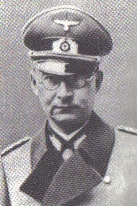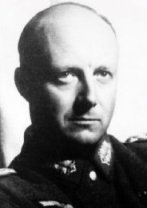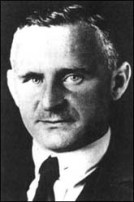![]()
Chapters
References
Assassination Attempt
 Freidrich Olbricht - Head of the OKH and fellow conspirator  Henning von Tresckow - initial close collaborator in the resistance  Carl Goerdeler - though initially skeptical of Stauffenberg's intentions in the resistance, came to a mutual understanding with him vis-à-vis the removal of Hitler  General Freidrich Fromm - commander of the reserve army whose wavering convictions would ultimately influence the success of a coup attempt |
Now that Stauffenberg had made up his mind to eliminate Hitler,
he set about securing both people and provisions necessary for
an overthrow. He no longer had faith in the generals of the OKW
(Oberkommando der Wehrmacht) to act. As he would remark to his
Uncle, Count von Uxkull, “Since the generals haven’t
accomplished anything, then it’s up to the colonels now.”[18] Uxkull recommended General Freidrich Olbricht who ran the OKH (Oberkommando
der Heeres) which was the army’s executive branch. This should
not be confused with the OKW which was more like today’s United
States Joint Chiefs of Staff. The OKH had within it many
officers who shared the same position as Stauffenberg concerning
Hitler, including Olbricht. Paraphrasing Hitler from his book
Mein Kampf (My Struggle) Stauffenberg pointed out that he “had
also written that to save a state from destruction, members of
that state had every right to rid it of destructive
leaders.”[19] Stauffenberg now felt that his personal oath of
loyalty to Hitler, sworn after the Rohm Affair, was no longer
binding. Now he could back up his way of thinking by using the
despot’s own words against him.
In September of 1943 Stauffenberg assisted Olbricht and another future conspirator, Major General Henning von Tresckow, revive plans for a coup. The OKH and Abwehr (German Military Intelligence) had already had plans for a possible coup drawn up as early as 1938 which would remove Hitler from power if Germany went to war over Czechoslovakia. This plan however was discarded after the success of the Munich Agreement. To see who would now be receptive to his plans, Stauffenberg immersed himself in the world of his fellow conspirators and was introduced to a wide circle of people most notably Carl Goerdeler, Fritz Dietlof Count von der Schulenburg, and Dr. Julius Leber. Goerdeler was the former Lord-Mayor of Leipzig and an early advocate of Hitler’s removal. Schulenburg and Leber were both members of a society in Germany called the Kreisau Circle which met in secret to discuss the ways in which removing Hitler could become a reality. “His new friends helped Stauffenberg refine his political philosophies, and he quickly became influential in the political circles of the resistance as well as the military circles."[20] His entrance and quick rise to influence did cause friction especially with Goerdeler who thought that Stauffenberg should stick to military issues pertaining to the coup. At the heart of the matter was the type of new government to be instituted after Hitler’s removal. While Goerdeler favored a republic not unlike Weimar, Stauffenberg wished to create a constitutional monarchy similar to Great Britain. However, “after several meetings each man came to respect the others ability and dedication to the cause, and their political differences were subordinated to their shared goal of toppling the Nazi regime."[21] Tresckow and Stauffenberg set about revising the 1938 coup plan code named Valkyrie which was designed, from a legal standpoint, to deal with various internal disturbances within the Third Reich. These disturbances were linked primarily with the millions of so called “foreign workers” in Germany and the possibility of them instigating violence. When the code word Valkyrie was issued units of the reserve army, basically trainees, soldiers on leave, and training staff and cadres would assemble immediately and be transformed into fighting units to deal with the disturbance. Both officers came up with the idea of using these plans as a pretext to stop a revolution by Nazi leaders once Hitler was dead. This would help endear the population to their cause and furthermore give legitimacy to their actions in the eyes of the army. “The entire plan to overthrow the regime, therefore, depended on an enormous hoax carried out in large part by scores of officers and troops obliviously following orders"[22] There was one snag on which everything Stauffenberg had worked for hinged. In order to successfully activate Valkyrie the commander-and-chief of the reserve army, General Freidrich Fromm, had to give authorization. Fromm was also another officer who was no fan of Hitler’s and he often expressed his distaste for the National Socialists within his private circle of friends. He was also no dummy either when it came to matters as serious as this. Perhaps his one fatal flaw, both to himself and eventually Stauffenberg, was that he always traveled the road of least resistance. Fromm would often boast to others that he, “always came down on the right side."[23] Although Fromm would probably not interfere with a coup attempt that Stauffenberg was planning, that also meant he might not support it when the critical hour arose. If Fromm would not sign off on Valkyrie then Stauffenberg was prepared to have the General arrested and carry out the Valkyrie order in his name. If this part of the plan were botched in any way, the coup would simply fail.
Public History at the University of North Carolina at Charlotte
|
